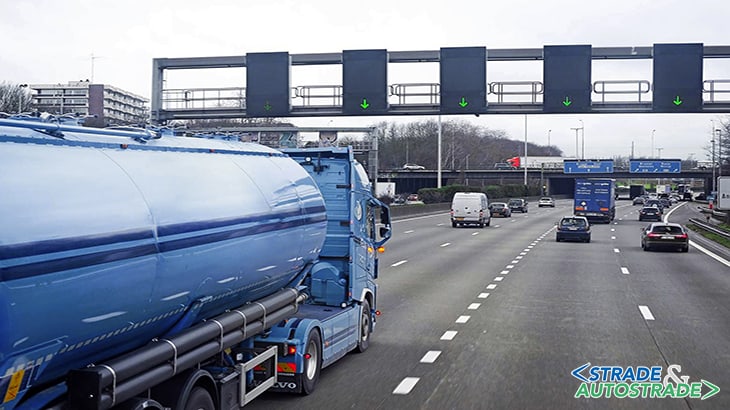The framework for the development of intelligent transport systems in Europe ![]() Per la versione in Italiano: https://www.stradeeautostrade.it/its-smart-road/il-quadro-per-lo-sviluppo-dei-sistemi-di-trasporto-intelligenti-in-europa/
Per la versione in Italiano: https://www.stradeeautostrade.it/its-smart-road/il-quadro-per-lo-sviluppo-dei-sistemi-di-trasporto-intelligenti-in-europa/
The ITS is an application system that applies information and communication technologies to transport. Many services are being developed, for the different modes of transport, in order to improve them, coordinate them and make them safer.
The study, commissioned by the Directorate-General MOVE to an independent Company, is aimed at assessing the scope of the ITS Directive and its relevance with the action plan on intelligent transport, which together form the legal, technical and general framework for the development of ITS (Intelligent Transport Systems) in the transport sector.
The evaluation is based on the results obtained by the 28 Member States in the period 2008-2018 and has the ultimate aim of helping the European Commission for a possible revision of the 2010 Directive.
The study divided the results obtained into five major areas: effectiveness, efficiency, relevance, coherence and european added value.
Effectiveness
The questions on effectiveness want to demonstrate whether the Directive meets the objectives that it has proposed. The analysis was based on the effectiveness of the support mechanisms provided by the Directive for the resolution of problems detected during its implementation.
As regards the adoption of the legislative framework, common standards and technical specifications, it can be said that they fully respond to the needs identified and their implementation is practically finished in (almost) all the Member States and in (almost) all sectors concerned.
The same goes for the NAP (National Access Points), which are indispensable for data sharing: almost all Member States have activated their NAP, even if for now they are not all fully operational and the exchange of data is therefore still limited.
It is in the field of setting up the infrastructure necessary for the development of the ITS that things get complicated; to date, only a limited number of infrastructures are fully operational at transnational level, which considerably limits the effectiveness of the TSIs and effectively prevents a correct assessment, which can only be carried out once the infrastructure has been set up at european level.

All the studies carried out so far, however, show that the TSIs will have an extremely positive impact on the transport sector in terms of safety, traffic fluidity and a decrease in the level of polluting emissions. The main obstacle to the full development of ITS in the various member countries is, in general, the cost of their implementation.
Furthermore, some States have proved to be not very receptive to their importance, preferring to channel their resources towards other types of solutions. European funding improved the equation, albeit not significantly. Another negative factor to note is the reluctance of some Member States to share national data, both for lack of trust and for high costs.
Efficiency
In this chapter, we want to check if the costs imposed by the Directive are proportional to the advantages it offers.
Costs for the Commission, Member States, ITS service providers and users have been considered. Although an in-depth analysis is difficult due to the incomplete implementation of the various ITS services, it can be said that the cost/benefit ratio is generally positive; the costs are judged not to be excessively high and, in the long term, the benefits will outweigh the costs incurred.
Relevance
The term relevance means how much the solutions proposed by the Directive are suitable for the real needs of users.
The study shows that all fields of application are covered by the various operational objectives of the Directive and that all of its initial objectives remain topical almost ten years after its entry into force.
The general objective of the ITS policy was to put into practice the mechanisms necessary to encourage the adoption of ITS services and applications in favor of road transport and their interconnection with other modes of transport.
The specific objectives were to increase the interoperability of the ITS at european level, put in place an effective cooperation mechanism, and solve data protection problems. All these goals are still valid, even if not yet fully achieved.
However, current affairs have brought to the table new objectives, such as the automation of vehicles, the promotion of ITS in urban areas, the interoperability between public and private transport and alternative mobility systems, which the Directive does not specifically take into account.
It would be good if the Commission, in case of revision of the Directive, dedicated a specific objective to them. In addition, the Directive will have to adapt to new technologies (such as 5G), providing for a specific common regulatory framework.

Coherence
Coherence is intended to determine whether the Directive responds to the needs and objectives of current Community policies. It is clear that an intelligent, modern and integrated transport system is an advantage not only for the transport sector, but also for all Community policies, be they economic, social or environmental.
The Directive, and the resulting Application Regulations, are coherent with EU Legislation and do not overlap with other current regulations. However, some aspects need to be explored, particularly in the field of data security, privacy protection and cybersecurity.
Well aware of the problem, the European Commission is preparing a proposal for a regulation on the subject of “privacy and electronic communications”, a European code for electronic communications and a directive on technical control of the ITS, which should be published by 2021.
European added value
The term european added value means that Community intervention is more advantageous than the intervention of individual states and that action can bring benefits to more than one member country.
In this case the Directive, by giving common technical specifications, severely limits the main risk of the TSIs, i.e. an inconsistent and fragmented development of the ITS (Intelligent Transport Systems) in the Community.
In the context of the development of the trans-european transport networks, action at european level is essential to guarantee the interoperability of the various applications.
Conclusion
Based on the evaluation of the Directive and its implementation, the study comes to some conclusions. The first is to improve the strategic framework to create a global strategy for the implementation of the ITS in the transport sector and to ensure its interoperability with other Community policies as well.
The second is to improve the presentation of the ITS to the general public, who still does not seem to be fully aware of it, to improve cooperation and the exchange of data between Member States.
The third, more specifically legislative, is to make some ITS applications on new vehicle models mandatory, to focus on any privacy issues and new measures (and possible penalties) to avoid Member States’ delays in implementation of the ITS, both as infrastructures and as applications.
The framework for the development of intelligent transport systems in Europe ![]() Per la versione in Italiano: https://www.stradeeautostrade.it/its-smart-road/il-quadro-per-lo-sviluppo-dei-sistemi-di-trasporto-intelligenti-in-europa/
Per la versione in Italiano: https://www.stradeeautostrade.it/its-smart-road/il-quadro-per-lo-sviluppo-dei-sistemi-di-trasporto-intelligenti-in-europa/

